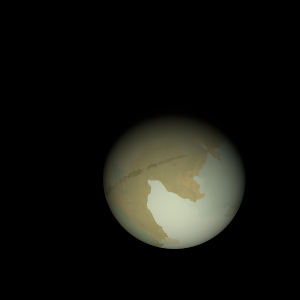|
|
Space Astro
|
Info for exoplanet "Ekyuge Kyo"
| Scientific (actual) data |
|---|
| Name | Kepler-647 b |
| Planet status | Confirmed |
| Radius | 0.104 |
| Orbital period | 16.2255 |
| Discovered | 2016 |
| Updated | 2021-02-05 |
| Tconj | 2454980 |
| Publication | Announced on a website |
| Detection type | Primary Transit |
| Alternate names | 2MASS J18590919+4435300 b, K00691.02, KIC 8480285 b, KOI-691 b, KOI-691.02, WISE J185909.19+443529.8 b |
| Star name | Kepler-647 |
| Right ascension | 284.79° |
| Declination | 44.59° |
| Mag j | 12.898 |
| Mag h | 12.585 |
| Mag k | 12.611 |
| Star distance | 789 |
| Star metallicity | -0.14 |
| Star mass | 1.03 |
| Star radius | 1.07 |
| Star age | 4.27 |
| Star temperature | 6020 |
| Star alternate names | 2MASS J18590919+4435300, KIC 8480285, KOI-691, WISE J185909.19+443529.8 |
| Wikipedia article | Kepler-647 b |
Back
| |
| Fictional info (?) |
|---|
| Suggested name | Ekyuge Kyo |
| Planet type | Cold planet |
| It has the longest rotation period (445 days) of any planet in its solar system and rotates in the opposite direction to most other planets. |
| Atmosphere | Nitrogen | 66% |
| Methane | 18% |
| Sulfur dioxide | 10% |
| Molecular hydrogen | 5.4% |
| Atmospheric pressure | 0.4 bar |
 |
| Moon | Pyapano'kemo | Small irregular ice moon |
| Konugogu | Medium-sized round rocky moon |
| Jogyasa | Small round gaseous moon |
| Nyunyu Moeryu | Small almost round rocky moon |
| Kadamu Ryu | Medium-sized slightly egg-shaped rocky asteroid |
| Toboapya-na | Large potato shaped rocky planetoid |
| Uwabawo | Huge round rocky comet |
| Pojazu Me | Large irregular ice planetoid |
| Gakya | Medium-sized almost round ice moon |
| Kyuju-ku | Small almost round gaseous comet |
| Pyonu Kyogyo | Large round ice asteroid |
| Yokebya | Small irregular rocky planetoid |
| Hibyu Hyopi'shu | Large irregular gaseous moon |
| Yanu Pera | Small irregular ice planetoid |
| Jito | Very small round crater-filled asteroid |
| Kaso-shu | Medium-sized almost round crater-filled comet |
| Noeho Ke | Small round rocky comet |
| Jitapyu Nyajo | Small irregular oceanic moon |
| Hakishi Ge | Small almost round rocky asteroid |
| Shihyu Chikyo Nya | Medium-sized slightly egg-shaped oceanic asteroid |
| Shoshogya | Very small almost round gaseous asteroid |
| Chui'serya | Medium-sized almost round gaseous moon |
| Gumyo'tsu | Very small slightly egg-shaped gaseous comet |
| Pyupagyu Romo | Huge almost round ice planetoid |
| Google search for Ekyuge kyo |
|
Website by Joachim Michaelis
|
|
|
|